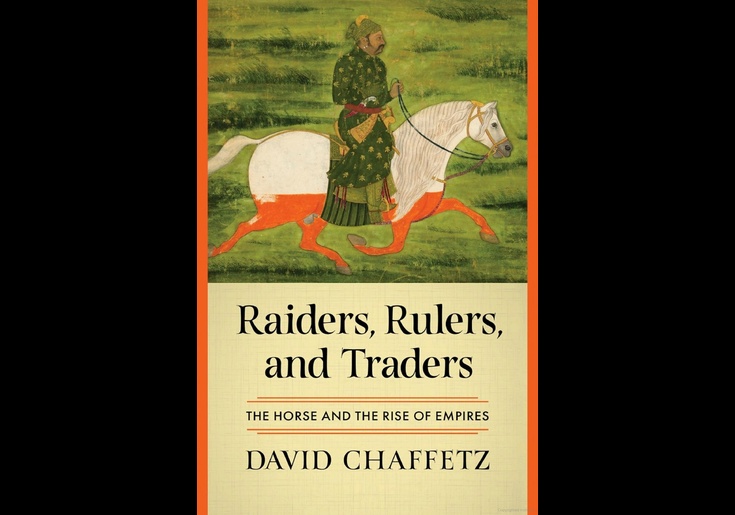And the Horses They Rode In On
REVIEW: ‘Raiders, Rulers, and Traders: The Horse and the Rise of Empires’ by David Chaffetz

We tend to forget now, but the Silk Road, as a kind of artery between great civilizations, dominated the world’s destiny for much of humankind’s collective experience. And, of course, the world has largely remembered the region from the perspective of those great chronicling cultures: China, India, Europe, the Mideast, and the like. In their nether zones sat the limitless tract of steppe lands from whose bourne emerged not just rich caravans of trade but wave after wave of warrior tribes on horseback. For upwards of a couple of millennia, from the Scythians to Attila to Genghis Khan and the Ottomans, they disturbed the settled order of things, sometimes even established their own order, but chiefly forged their achievements through predation on the older, more recognized societies.
So much for conventional history. It wasn’t until the collapse of the Soviet Union allowed access both to the geographical area and to original documents that a fresh picture—a more Silk Road-centric picture, if you will—began to surface via a new genre of history book written with the additional perspective of the steppe-cultures themselves. Raiders, Rulers, and Traders: The Horse and the Rise of Empires by David Chaffetz is such a book, one that overlaps with another popular genre, that of the “micro-history,” in which development down the ages is seen through the impact of a particular item.
Raiders is, in fact, all about the role of the horse as a critical abettor of the human narrative, for good or ill, through the centuries right up to the end of World War I. Chaffetz tells a highly readable and erudite tale of the horse from its beginnings in the wild to its domestication and ultimately its contribution to the dramatic rise and fall of empires. He argues that “what we now call the Silk Road should more accurately be called the Horse Road.” Thankfully he doesn’t apply the clunky phrase inside the book, but pretty soon, we get what he means.
Any such history must, perforce, be focused on the steppe with, according to Chaffetz, 1.1 million miles of grasslands providing the most natural indigenous landscape for the subsistence and easy rearing of horses. Conversely, good arable land “was stoutly defended by local farmers” and “was too wet for horses anyway.” Thus originated the timeless antipathy between urban civilizations fed by cultivated crops and the tribal nomads they deemed barbarian. For shorthand, Chaffetz chooses to call the latter “horse-breeders,” the universal defining activity of all such tribes. The author takes us from the initial symbiosis of keeping horses for milk and meat somewhere in the wilds of today’s Kazakhstan to riding bareback to the invention of the wheel for carts and ultimately for charioting—all between the third and first millennia B.C. Along the way, our ancestors became so attached to their equine companions that they created tomb-shrines for their favorites.
Horse culture didn’t exert a pivotal force on wider human affairs until cavalry replaced chariots as a weapon of war sometime in the first millennium B.C. And not quite decisively even then, not until an Altaic tribe invented the light, strong, and relatively small composite bow, thereby changing the “next twenty-five hundred years of mounted warfare.” As he relates the passage of centuries, Chaffetz demonstrates beyond doubt that history does repeat itself simply by showing how settled civilizations all repeated the same disastrous pattern in facing the “horse-breeder” threat. They struggled to keep them out and usually failed (vide China’s Great Wall), chased them into the steppe and often got decimated, tried to bribe them and only made them stronger, hired them as imperial cavalry, strove to emulate them, purchased their horses in bulk, all largely to no avail. When horse warriors did conquer more affluent settled cultures—from Kublai Khan in China to the Moghuls in India—they repeated their own fatal patterns, growing fat and lazy on court life only to be ousted by a new wave of mounted rivals.
It would be misleading to suggest that Chaffetz’s saga is exclusively or even mainly about wars and conquest. As the title indicates, there’s a good deal about trading and breeding, sometimes on a vast scale involving tens of thousands of horses. We learn that equine markets or fairs grew in size and importance, from Iran to India to China, often with patronage from monarchic wealth, until they evolved a kind of sacred pageantry. Not surprising in a landmass where horsepower made the difference between survival and destruction. Toward the creature that determines your fate, feelings akin to worship were never far from the surface. Chaffetz doesn’t shy from exploring the more elegiac or artistic side of his tale. Extracts of equestrian poetry and splendid illustrations pepper the text—a maharajah’s favorite mount, Tang Dynasty ceramics of polo-playing ladies, a legendary Akhal-Teke Turkmen stallion grazing, and the like.
Riding alongside Chaffetz on his epic narrative, we come across once-familiar nuggets of knowledge long since buried in our collective consciousness. The difference between Kazakhs and Cossacks for example: the latter were self-organized Christian imitators of the marauder lifestyle. Settled empires that became nation-states like China, Russia, and Iran were as often ruled and populated by Turco-Mongol tribes as the national ethnicity each now claims as dominant. According to Chaffetz, “The number of horses controlled by the Mongols rose to … ten million … half the world’s total.” The word for Cathay derives from the Khitans, a sub-Mongolian tribe that ruled China as the Liao dynasty circa 1000 A.D. The joy of etymology is part of the book’s many attractions.
Every so often, without apology and often without a definition, the author throws in startlingly esoteric words such as monopsony, geomancy, endorheic, and ungulates. (You are welcome to Google them just as I had to.) It doesn’t come across as showing off. Chaffetz’s erudition gallops along at such an ebullient pace that you absorb it all with rapt attention. His book has, in effect, reopened a window on lands and epochs that were the very substance of exotic legend and allowed us to inhabit anew the wonder they evoked.
Raiders, Rulers, and Traders: The Horse and the Rise of Empires
by David Chaffetz
W.W. Norton, 448 pp., $32.50
Melik Kaylan writes about culture and the arts for the Wall Street Journal.




